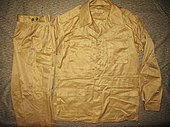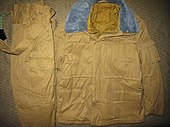Afghanka
This article includes a list of general references, but it remains largely unverified because it lacks sufficient corresponding inline citations. (February 2019) |
This article needs additional citations for verification. (March 2019) |
| Afghanka | |
|---|---|
  Two types of Afghanka uniforms. The summer version (Left) and the winter version (Right). | |
| Type | Military uniform |
| Place of origin | USSR |
| Service history | |
| In service | 1980s - Present |
| Wars | Soviet–Afghan War First Chechen War |
| Production history | |
| Variants | See Variants |
The Afghanka (Russian: Афганка) (proper designation: M88) is a type of military uniform system developed and issued by the Soviet Army in the early 1980s, still in use today in some Post-Soviet states in many different variants. The name Afghanka is an unofficial popular slang term in Russian for the uniform, derived from its prolific use during the Soviet–Afghan War. All the non-sand coloured versions of the M88 are not called Afghanka.
They are typically made of cotton (Russian: хлопчатая бумага or "Х/б", "cotton paper").
Design details[]
The Afghanka field uniform is made in a lightweight summer and heavier, lined winter version; both consist of a long, loose fitting 6-pocket BDU-style jacket with large stand-and-fall collar, epaulettes, concealed buttons, armpit vents, and tube-style field trousers with cargo pouches on the thighs. A field cap made from sturdier cotton and featuring ear flaps which could be unbuttoned and lowered to protect the ears was supplied with the uniform.[1]
The winter model is composed of: jacket, jacket liner, trousers, plus insulated liners and suspenders. The liners are buttoned into their respective garments, and the outer garment can be worn without the liners. The jacket liner bears the fur collar of the jacket, usually in fish fur but occasionally in real fur (officer's uniforms). The jacket and trousers are lined with a pile-type material that helps insulate by trapping warm air, whereas the liners are made of a quilted material similar to the Telogreika uniform.
Colouring[]
Both uniforms were originally made in a khaki-coloured material, but later types were developed in olive drab, tan, and sage green, allegedly intended for use in different environmental theatres of operation.

Since the fall of the Soviet Union, the Afghanka has been copied and issued widely by CIS members in various localized camouflage patterns.
Operational history[]

The Afghanka began appearing in military units in the early 1980s during the Soviet–Afghan War, hence the name. The design of the jacket and trousers may have been based on similar patterns used by other Warsaw Pact armies such as the Nationale Volksarmee of the GDR. Initially only used in Afghanistan, the Afghanka uniform was in very short supply and was often issued to units rather than individuals and passed around as necessary for various duties. As more were produced, more were issued. By the end of the 1980s it had become possible for everybody to be issued his own. Individual soldiers began marking the collars of their uniforms with bleach. In 1988 the uniform was adopted as standard issue, replacing the ageing M69/73 Uniform in all theaters.
The soldiers found the new uniform to be very effective, especially in Afghanistan. Even without the liners in, a winter Afghanka is comfortably warm in temperatures of down to −20 °C. Another advantage of the winter Afghanka over the preceding Bushlat and Shinel greatcoat was the greatly enhanced mobility and increased number of pockets.
Variants[]
The Afghanka was initially issued to regular units of the armed forces in a khaki colour. The uniform was also standardized with the KGB Border Troops, but in the service's unique "birch" camouflage pattern (similar to that used on the KLMK camouflage coverall) as well as Soviet Marines, who were the first to be issued with the newest Soviet camouflage development of the time—the woodland-style three-coloured Butane pattern (also known informally as ).
Although derived from a previous chemical-warfare uniform known as OKZK-D, the camouflage uniform made for VDV paratroopers in 1984 included many features from the Afghanka. Since then, various other uniforms evolved from the Afghanka in various camouflage patterns—such as VSR (the standard field uniform of the Russian Armed Forces since 1993, and later flora camouflage (issued since 1998), and many others. Belarus, Kazakhstan and Ukraine both currently issue Afghanka-cut uniforms in their own camouflage patterns.
The Soviet and Russian VDV model, made in either khaki, Butane, or VSR, lacked the lower patch pockets on the jacket as the blouse was intended to be worn tucked inside the trousers, to better accommodate the numerous harnesses used with a parachute. Both the USSR and the Russian Federation have also produced the uniform in plain colours for paramilitary use.
See also[]
Notes[]
- ^ Camouflage Uniforms of the Soviet Union and Russis, Dennis Desmond, Schiffer Military History, copyright 1998, ISBN 0-7643-0462-3[page needed]
Sources[]
- Soviet Uniforms and Militaria 1917–1991 by Laszlo Bekesi The Crowood Press UK (June 30, 2011), ISBN 978-1847972606
- Inside the Soviet Army Today. Osprey Elite Military History Series No. 12 by Stephen J Zaloga
- Russia's War in Afghanistan by David Isby
- Warsaw Pact Ground Forces by David Rottmman
| Wikimedia Commons has media related to Afganka. |
- Soviet military uniforms